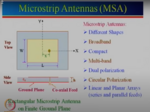yefj
Advanced Member level 4
Hello on the antenna bellow we have L=half wave length.
I understand that we have open circuit on the edges so currect is zero on edges
but why its maximal in the middle ,and why voltage acts by going from +vmax on one edge to -Vmax on other edge.
is there some physical explanation for it?
Thanks.

I understand that we have open circuit on the edges so currect is zero on edges
but why its maximal in the middle ,and why voltage acts by going from +vmax on one edge to -Vmax on other edge.
is there some physical explanation for it?
Thanks.
